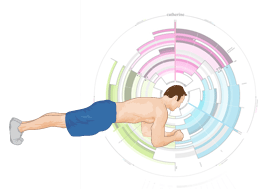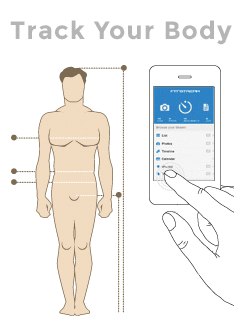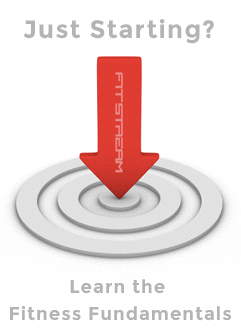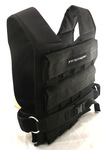This article gives a concise and easy to understand guide to one of the most frequently asked health and fitness questions - How do I lose weight and burn fat?
Based on core principles and simple rules, it’s perfect for beginners who want to lose weight without getting bogged down in science and jargon.
Weight loss can be boiled down to one fundamental rule -
- Consume fewer calories than you burn.
You can control this rule through two main factors:
- Calorie output as determined by your activity level
- Calorie input as determined by your food intake
So, it shouldn’t come as any surprise that what we’re talking about is exercise and diet, but before tackling these two topics it’s important that you approach your weight loss goal in the right way...
 Fat Burning Mind Set
Fat Burning Mind Set
You didn’t get fat overnight. The journey is a marathon, not a sprint, so you should acknowledge that what you’re doing is deciding to be healthier and more active.
The process won’t be pleasant at first as it’s a change from what you’re used to. You will struggle both mentally and physically, but as you get leaner and fitter, it will gets easier and many people learn to enjoy their healthier approach to life.
Being realistic helps avoid disappointment and aids with motivation. Set your fat loss goals to something achievable (1-2 lbs per week as a general guide) and hit them, consistently. If this sounds low remember that there’s a limit to the amount of fat that can be burned before you’re losing muscle mass too!
Here are some other pointers or myths to know about before we get into the fat loss approach...
- Your genes determine your capacity for storing fat, and where it’s likely to be stored.
- You can’t ‘target’ certain areas for fat loss. This is called ‘spot reduction’ and you should forget you ever heard about it.
- The volume of body fat you start with will determine your rate of weight loss and as your body fat percentage decreases, the rate of fat loss will decline.
- Genetics will determine the shape of your muscles when fully developed.
Exercising for Fat Loss
The guiding principle of calorie expenditure is that -
- The greater your activity level, the more calories you burn.
An exercise routine is a great way to manage your activity levels in a structured, focused and intelligent manner. The most important two factors of your training are:
- Consistency / frequency - training often enough to make continuous improvements and burn the required calories in the appropriate timeframe.
- Intensity - to determine the amount of calories burned and the extent of your physical progress.
How to Exercise when you're Overweight
How you should exercise can be a controversial topic. The important thing is that you don’t dwell so much on the how, when and where... and ensure that you simply get started and learn on the job!
If you’re just starting out, choose a training plan from a professional and test it out for a couple of months, or until you have enough experience to tailor it to your needs. The key here is not to find the “golden routine”, as there is no such thing, but to find a handful of training methods that you respond well to and feel you can commit to. In time you will learn how and when to cycle through them to enhance their impact on your body and overall health. It’s as simple as that.
There isn’t really a true consensus on the best method of exercise, and it varies from person to person but if fat loss is your aim we’ve included some pointers below -
- Combine weight training with cardio (such as sprinting, swimming, biking).
- Practice interval training; short bursts of intense activity, followed by periods of rest... and repeat.
- Perform multi-joint, compound exercises such as the squat and deadlift.
- More muscle in the body means more calories burned at rest.
If you’re very out of shape, starting to exercise is likely to be both mentally and physically challenging as your body is not use to the stress. However, the discomfort is short lived as the body fights through years of neglect and it gets much easier and more enjoyable as you gain in fitness.
If you’re carrying a lot of excess weight it can be best to start with some lower impact training such as walking, biking or swimming to kick-start your training and help lose those initial pounds before progressing to jogging and weight training.
Whilst exercise plays a critical role in fitness and weight loss, it’s less than half the story. To put it into perspective, consider that running for a single mile will burn a little over 100 calories, and the average chocolate bar will have around 220 calories.
Which leads us on to the next, and most important approach to weight loss - your food. As it’s famously known - you can’t out train a bad diet.
Dieting for Fat Loss
Diet is the most important factor in weight loss. Make healthier food choices, create a calorie deficit and you will burn fat stores.
Calorie Tracking
Starting to calorie track is one of the easiest ways to understand your daily intake.
It may feel like an inconvenience at first but if you’re overweight, you have a calorie debt that you haven’t repaid and are likely to be making poor food choices. Tracking food consumption will make you more aware of what you’re taking in, any deficiencies and calorie input. Over time, as you gain experience and become more in tune with your body, you’ll understand how to adapt your diet and eat healthier.
There’s a selection of comprehensive, free calorie tracking applications that make this easy for you. Check out MyFitnessPal or FitDay for excellent examples.
If you’ve decided to calorie track, you obviously need to understand how many calories you should be consuming in order to lose weight. This brings us to...
Calculating Target Calorie Deficit
To calculate your target calorie deficit in order to stimulate weight loss you must first find your Total Daily Energy Expenditure (TDEE), that is the number of calories you need each day just to maintain your present weight, with your current activity level.
There are two main approaches you can use:
- Manually tracking your diet and weight with detailed records of food intake for the more diligent folk amongst us. This will gauge an accurate value that’s specific to you.
or by using an...
- Automated calorie estimation tool, based on scientific formulas for a best guess estimate, but this is likely to have a greater margin of error.
Manually Calculating TDEE
- Track the number of calories you consume every day for a period of around 2-3 weeks (using a food logging app, pen and paper, spreadsheet... or whatever means you prefer).
- Note your weight at the beginning and end of the time period.
- Calculate your average calories consumed over the period for your TDEE and then make an adjustment for any difference in weight recorded during the tracking period. Note that one pound of fat equates to 3500 calories.
- For example, if you tracked an average of 3500 calories per day for 14 days, and found that at the end of the process you had put on 2lbs, this would equate to 7000 additional calories over that period (1lb fat = 3500 cals). This would represent a calorie excess of 500 per day, so your TDEE would be 3500 - 500 = 3000.
With the above example you know that just to maintain your current body, your calorie intake should be roughly 3000 / day.
- Example TDEE: 3000 calories
- Example weight loss goal: 2lbs / week
If your weight loss goal is 2lbs per week, and we know that 3500 calories equates to 1lb of fat, this represents a total required calorie deficit of 7000 calories for the week, or 1000 calories per day.
Subtract your daily calorie deficit from your TDEE to calculate your target average calorie intake for the day, in order to lose your target amount of body fat.
In the above example, this would be:
- Target daily calories for fat loss = 2000 (3000 - 1000)
With these example values you could expect to lose around 2lbs of fat per week.
This is a guide, but it certainly adds some structure to the process and helps you understand intake and make the associations with the effect on your body.
In actual fact you may find that you lose more than your target fat amount with your deficit calculation, as fat stores also cause your body to retain water weight too, which will be lost as the fat is burned.
Weight Loss Summary
- Losing weight is not rocket science. Generally, if you eat less and move more, you will lose weight.
- One of the key factors to successful weight loss is having the correct mind set. It’s going to take time and dedication to shift excess fat and will require a lifestyle change.
- Calorie tracking and calculating your TDEE is a useful way to understand your food consumption and on how to adapt it to better suit your goals and activity levels.










